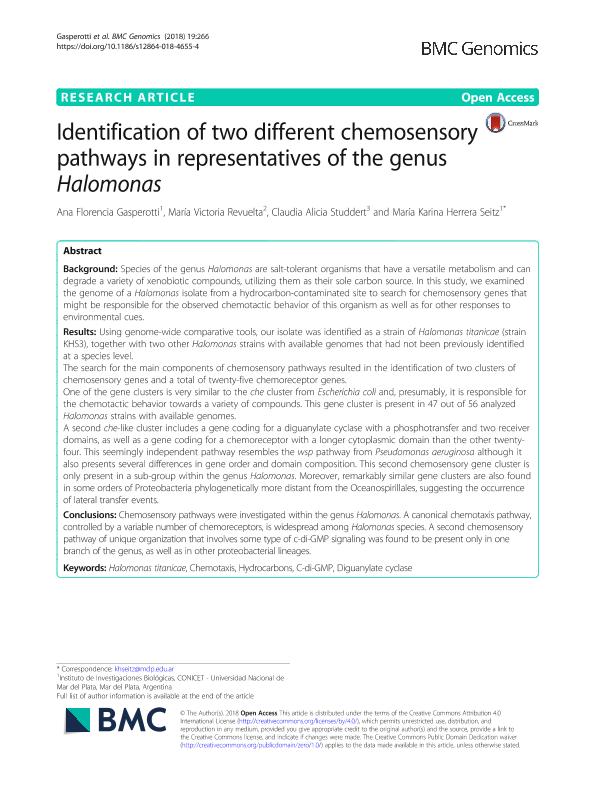Mostrar el registro sencillo del ítem
dc.contributor.author
Gasperotti, Ana Florencia

dc.contributor.author
Revuelta, María Victoria

dc.contributor.author
Studdert, Claudia Alicia

dc.contributor.author
Herrera Seitz, Karina

dc.date.available
2019-10-21T17:59:15Z
dc.date.issued
2018-04
dc.identifier.citation
Gasperotti, Ana Florencia; Revuelta, María Victoria; Studdert, Claudia Alicia; Herrera Seitz, Karina; Identification of two different chemosensory pathways in representatives of the genus Halomonas; BioMed Central; BMC Genomics; 19; 1; 4-2018; 266-281
dc.identifier.issn
1471-2164
dc.identifier.uri
http://hdl.handle.net/11336/86663
dc.description.abstract
Background: Species of the genus Halomonas are salt-tolerant organisms that have a versatile metabolism and can degrade a variety of xenobiotic compounds, utilizing them as their sole carbon source. In this study, we examined the genome of a Halomonas isolate from a hydrocarbon-contaminated site to search for chemosensory genes that might be responsible for the observed chemotactic behavior of this organism as well as for other responses to environmental cues. Results: Using genome-wide comparative tools, our isolate was identified as a strain of Halomonas titanicae (strain KHS3), together with two other Halomonas strains with available genomes that had not been previously identified at a species level. The search for the main components of chemosensory pathways resulted in the identification of two clusters of chemosensory genes and a total of twenty-five chemoreceptor genes. One of the gene clusters is very similar to the che cluster from Escherichia coli and, presumably, it is responsible for the chemotactic behavior towards a variety of compounds. This gene cluster is present in 47 out of 56 analyzed Halomonas strains with available genomes. A second che-like cluster includes a gene coding for a diguanylate cyclase with a phosphotransfer and two receiver domains, as well as a gene coding for a chemoreceptor with a longer cytoplasmic domain than the other twenty-four. This seemingly independent pathway resembles the wsp pathway from Pseudomonas aeruginosa although it also presents several differences in gene order and domain composition. This second chemosensory gene cluster is only present in a sub-group within the genus Halomonas. Moreover, remarkably similar gene clusters are also found in some orders of Proteobacteria phylogenetically more distant from the Oceanospirillales, suggesting the occurrence of lateral transfer events. Conclusions: Chemosensory pathways were investigated within the genus Halomonas. A canonical chemotaxis pathway, controlled by a variable number of chemoreceptors, is widespread among Halomonas species. A second chemosensory pathway of unique organization that involves some type of c-di-GMP signaling was found to be present only in one branch of the genus, as well as in other proteobacterial lineages.
dc.format
application/pdf
dc.language.iso
eng
dc.publisher
BioMed Central

dc.rights
info:eu-repo/semantics/openAccess
dc.rights.uri
https://creativecommons.org/licenses/by-nc-sa/2.5/ar/
dc.subject
C-DI-GMP
dc.subject
CHEMOTAXIS
dc.subject
DIGUANYLATE CYCLASE
dc.subject
HALOMONAS TITANICAE
dc.subject
HYDROCARBONS
dc.subject.classification
Biología Celular, Microbiología

dc.subject.classification
Ciencias Biológicas

dc.subject.classification
CIENCIAS NATURALES Y EXACTAS

dc.title
Identification of two different chemosensory pathways in representatives of the genus Halomonas
dc.type
info:eu-repo/semantics/article
dc.type
info:ar-repo/semantics/artículo
dc.type
info:eu-repo/semantics/publishedVersion
dc.date.updated
2019-10-18T18:44:03Z
dc.journal.volume
19
dc.journal.number
1
dc.journal.pagination
266-281
dc.journal.pais
Reino Unido

dc.journal.ciudad
Londres
dc.description.fil
Fil: Gasperotti, Ana Florencia. Consejo Nacional de Investigaciones Científicas y Técnicas. Centro Científico Tecnológico Conicet - Córdoba. Instituto de Investigaciones Biológicas y Tecnológicas. Universidad Nacional de Córdoba. Facultad de Ciencias Exactas, Físicas y Naturales. Instituto de Investigaciones Biológicas y Tecnológicas; Argentina
dc.description.fil
Fil: Revuelta, María Victoria. Consejo Nacional de Investigaciones Científicas y Técnicas. Centro Científico Tecnológico Conicet - Córdoba. Instituto de Investigación Médica Mercedes y Martín Ferreyra. Universidad Nacional de Córdoba. Instituto de Investigación Médica Mercedes y Martín Ferreyra; Argentina
dc.description.fil
Fil: Studdert, Claudia Alicia. Consejo Nacional de Investigaciones Científicas y Técnicas. Centro Científico Tecnológico Conicet - Santa Fe. Instituto de Agrobiotecnología del Litoral. Universidad Nacional del Litoral. Instituto de Agrobiotecnología del Litoral; Argentina
dc.description.fil
Fil: Herrera Seitz, Karina. Universidad Nacional de Mar del Plata. Facultad de Ciencias Exactas y Naturales. Instituto de Investigaciones Biológicas; Argentina
dc.journal.title
BMC Genomics

dc.relation.alternativeid
info:eu-repo/semantics/altIdentifier/doi/http://dx.doi.org/10.1186/s12864-018-4655-4
Archivos asociados
